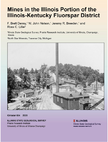Cave-in-Rock Subdistrict: Difference between revisions
Alan.Myers (talk | contribs) No edit summary |
Alan.Myers (talk | contribs) No edit summary |
||
| Line 25: | Line 25: | ||
{{#css: | {{#css: | ||
#ca-key1 { display:none!important; } | #ca-key1 { display:none!important; } | ||
}}== Mines enter | }}== Mines enter that are in the {{PAGENAME}} == | ||
{{#ask: [[Has parent page::Cave-in-Rock Subdistrict]] | {{#ask: [[Has parent page::Cave-in-Rock Subdistrict]] | ||
|- | |- | ||
Revision as of 10:47, June 7, 2021
The Cave-in-Rock Subdistrict is the largest bedding replacement district within the IKFD. It trends in a northeast–southwest direction and lies southeast of the Rock Creek Graben and Peters Creek Fault Zone (Figure 19). Bastin (1931), Weller et al. (1952), and Brecke (1962) provided historical information on the individual mines. The map and report by Baxter et al. (1963) located numerous mines but contained little historical information. Data from the files of the Ozark-Mahoning and Minerva Oil Company were instrumental in determining the location and details of some of the properties.
Ore bodies in the Cave-in-Rock Subdistrict are typically 3 to 15 feet thick and 50 to 150 feet wide and extend for more than 2,000 feet along strike (Weller et al. 1952). Banded-texture or coontail ore is common in bedding replacement deposits and has been observed along the periphery of some of the veins. Banded ore is not exclusive to the Cave-in-Rock Subdistrict and has been reported as associated with vein ore in the Empire District, Redd Mine, Oscar Crabb Prospect, Slapout Mine, Sheldon Property, Seinor Prospects, Stewart Mine, Compton Mine, and others (Weller et al. 1952). Some of the mines at the southern end of this district dug gravel spar, but most in the district were underground operations employing a modified room-and-pillar mining method. The rooms were up to 150 feet wide and commonly trend in a northeasterly direction. Pillars were left in random configurations to extract as much fluorspar as possible without causing roof failures.
Mines worked multiple stratigraphic levels, including the Ste. Genevieve Limestone (oldest) and the Levias, Shetlerville, and Downeys Bluff Members of the Paoli Limestone. The levels were named for the unit overlying the mineralized strata. Thus, mineralization in the “Bethel Level” occurred within the underlying Downeys Bluff Limestone beneath the thin, shaly sandstone and indurated gray sandstone of the Bethel. The top of the Ste. Genevieve Limestone, just below the Aux Vases Sandstone, was called the “Rosiclare Level.” The lithology of the strata occurring at the contact between the Aux Vases and Ste. Genevieve is variable. Brecke (1962) described the roof in the Rosiclare Level as green plastic shale, silty shale, and limestone interbedded with sandy limestone. The “sub-Rosiclare Level” occurs in the Ste. Genevieve below the Rosiclare Level, and the Spar Mountain Level occurs below the Sub-Rosiclare Level approximately 60 feet below the base of the Aux Vases Sandstone. At this level, calcareous sandstone overlies oolitic to dense limestone (Brecke 1962). The Spar Mountain Sandstone is lenticular, being 0 to 3 feet thick in the Hill Mine and absent in some places at the Davis-Deardorff Mine. Although impermeable roof rock such as shale halted the upward movement of ore-bearing fluids, Weller et al. (1952) pointed out that some ore bodies in the Cave-in-Rock area lacked an impermeable “cap rock” (i.e., barrier to gas or fluid movement). Finally, a working level near the base of the Ste. Genevieve Limestone has been named the Cadiz Level.
Mahoning Mines or Ozark-Mahoning Group of Mines

